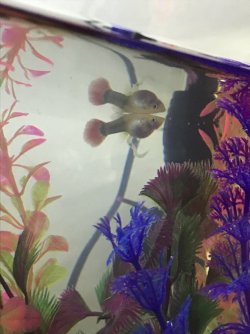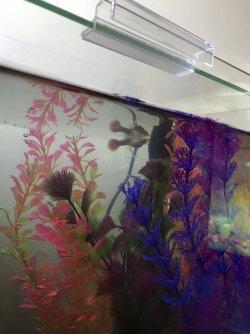You are using an out of date browser. It may not display this or other websites correctly.
You should upgrade or use an alternative browser.
You should upgrade or use an alternative browser.
Guppy problem
- Thread starter Daniellie
- Start date
Hopefully it's a big white poop and not the fish's intestine. Monitor it and if it falls off then it's poop. If it stays there for a few days it could be the fish's intestine. There's not much you can do if that is the case.
What's the swim bladder symptoms you mention?
This could be an internal bacterial infection that is killing them.
Can you post a picture of all the fish, including the one in the hospital tank?
How long have you had the fish for?
Have you added anything to the tank in the last few weeks?
This could be an internal bacterial infection that is killing them.
Can you post a picture of all the fish, including the one in the hospital tank?
How long have you had the fish for?
Have you added anything to the tank in the last few weeks?
All three fish struggled to keep themself upright. They struggled against the filter current and swam as if they had no control of where they were going. I have 5 guppies and one molly left. I’ve had my molly and the two female guppies for about 5 months and I recently added 5 guppies about two weeks ago. Unfortunately I’m at work so can’t get pictures at the moment. The others look perfectly normal and the one in the hospital tank has been swimming about without control of where she’s going however looks fine.
Did this problem start after you added the 5 new guppies?
If yes, they probably brought a protozoan or bacterial infection in with them.
All new fish should be quarantined for a month before being added to the main display tank to prevent things like this happening. However, it's too late now.
What is the GH (general hardness), KH (carbonate hardness) and pH of your water supply. This information can usually be obtained from your water supply company's website or by telephoning them. If they can't help you, take a glass full of tap water to the local pet shop and get them to test it for you. Write the results down (in numbers) when they do the tests. And ask them what the results are in (eg: ppm, dGH, or something else).
Guppies need a GH around 200ppm and a pH above 7.0.
------------------------
Wipe the inside of the glass down with a clean fish sponge.
Do a 75% water change and gravel clean the substrate. Make sure any new water is free of chlorine/ chloramine before it's added to the tank.
Then add salt.
You can add rock salt (often sold as aquarium salt), sea salt or swimming pool salt to the aquarium at the dose rate of 2 heaped tablespoon per 20 litres of water.
If you only have livebearers (guppies, platies, swordtails, mollies), goldfish or rainbowfish in the tank you can double that dose rate, so you would add 4 heaped tablespoons per 20 litres.
Keep the salt level like this for at least 2 weeks but no longer than 4 weeks otherwise kidney damage can occur. Kidney damage is more likely to occur in fish from soft water (tetras, Corydoras, angelfish, gouramis, loaches) that are exposed to high levels of salt for an extended period of time, and is not an issue with livebearers, rainbowfish or other salt tolerant species.
The salt will not affect the beneficial filter bacteria but the higher dose rate will affect some plants. The lower dose rate will not affect plants.
After you use salt and the fish have recovered, you do a 10% water change each day for a week using only fresh water that has been dechlorinated. Then do a 20% water change each day for a week. Then you can do bigger water changes after that. This dilutes the salt out of the tank slowly so it doesn't harm the fish.
If you do water changes while using salt, you need to treat the new water with salt before adding it to the tank. This will keep the salt level stable in the tank and minimise stress on the fish.
If yes, they probably brought a protozoan or bacterial infection in with them.
All new fish should be quarantined for a month before being added to the main display tank to prevent things like this happening. However, it's too late now.
What is the GH (general hardness), KH (carbonate hardness) and pH of your water supply. This information can usually be obtained from your water supply company's website or by telephoning them. If they can't help you, take a glass full of tap water to the local pet shop and get them to test it for you. Write the results down (in numbers) when they do the tests. And ask them what the results are in (eg: ppm, dGH, or something else).
Guppies need a GH around 200ppm and a pH above 7.0.
------------------------
Clean the filter if it hasn't been done in the last 2 weeks. Wash filter media/ materials in a bucket of tank water and re-use them.
Wipe the inside of the glass down with a clean fish sponge.
Do a 75% water change and gravel clean the substrate. Make sure any new water is free of chlorine/ chloramine before it's added to the tank.
Then add salt.
You can add rock salt (often sold as aquarium salt), sea salt or swimming pool salt to the aquarium at the dose rate of 2 heaped tablespoon per 20 litres of water.
If you only have livebearers (guppies, platies, swordtails, mollies), goldfish or rainbowfish in the tank you can double that dose rate, so you would add 4 heaped tablespoons per 20 litres.
Keep the salt level like this for at least 2 weeks but no longer than 4 weeks otherwise kidney damage can occur. Kidney damage is more likely to occur in fish from soft water (tetras, Corydoras, angelfish, gouramis, loaches) that are exposed to high levels of salt for an extended period of time, and is not an issue with livebearers, rainbowfish or other salt tolerant species.
The salt will not affect the beneficial filter bacteria but the higher dose rate will affect some plants. The lower dose rate will not affect plants.
After you use salt and the fish have recovered, you do a 10% water change each day for a week using only fresh water that has been dechlorinated. Then do a 20% water change each day for a week. Then you can do bigger water changes after that. This dilutes the salt out of the tank slowly so it doesn't harm the fish.
If you do water changes while using salt, you need to treat the new water with salt before adding it to the tank. This will keep the salt level stable in the tank and minimise stress on the fish.
Similar threads
- Replies
- 4
- Views
- 1K
- Replies
- 7
- Views
- 448



